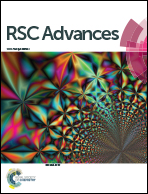Effect of the Li+ ion on the multimodal emission of a lanthanide doped phosphor
Abstract
The present study probes the multimodal emission: upconversion (UC), photoluminescence (PL) and quantum cutting (QC) processes in a Ho3+/Yb3+ co-doped Y2O3 phosphor and further examines the impact of the Li+ ion on the multi-modal emission, for the first time. The materials give efficient emission in the green region both through UC and PL, while efficient NIR emission is observed through the QC process. Co-operative energy transfer (CET) has been ascribed as the possible mechanism for QC; as a result of which a UV/blue photon absorbed by a Ho3+ ion splits into two near infrared photons (wavelength range 950–1000 nm) emitted by a Yb3+ ion pair. The Yb3+ concentration dependent ET efficiency and QC efficiency has also been evaluated. The energy transfer from Ho3+ to Yb3+ has been calculated and the efficiency is around 82%, and so, the corresponding QC efficiency is 182%. Co-doping of the Li+ ion has been found to enhance the efficiency of QC emission by about 8%, similar to that of UC and PL emission, and hence the multimodal emission is enhanced. Such NIR QC phosphors have great promise in energy conversion for c-Si solar cell applications.


 Please wait while we load your content...
Please wait while we load your content...